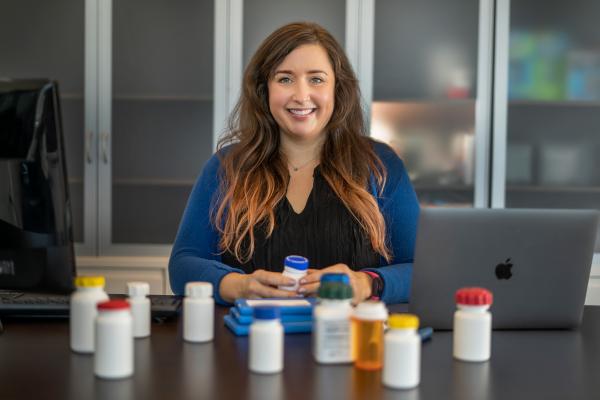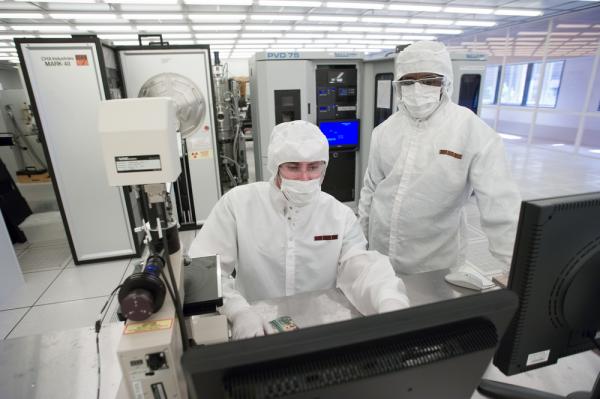By Michael Pearson
In the National Institutes of Health’s urgent $500 million initiative to quickly ramp up the country’s Covid-19 testing capacity, the road to success passes right through Atlanta — and the Georgia Institute of Technology.
Georgia Tech faculty at units including the School of Public Policy’s HomeLab, the Institute for Electronics and Nanotechnology (IEN), and the Wallace H. Coulter Department of Biomedical Engineering at Georgia Tech and Emory University — are playing crucial roles in the NIH’s -Rapid Acceleration of Diagnostics (RADx) initiative to speed development, evaluation, and commercialization of new Covid-19 tests for use at home, in doctor’s offices, and in labs.
The units are working with the Atlanta Center for Microsystems Engineered Point-of-Care Technologies (ACME POCT) — which includes Georgia Tech, Emory University, and Children’s Healthcare of Atlanta — to vet candidate tests. The eventual widespread distribution of the test kits — which, in some cases, may offer almost instant results — of successful candidate tests could be key factors in helping limit spread of the disease, fully reopening the economy, and getting students back in classrooms.
“NIH recognizes the crucial role that those of us here in Atlanta are playing in the success of this national initiative,” said Wilbur Lam, an associate professor in the Biomedical Engineering Department, and one of three principal investigators at ACME POCT. Lam is also an associate professor at the Emory University School of Medicine.
The Center, part of NIH’s Point-of-Care Technologies Research Network (POCTRN), includes Georgia Tech, Emory University and Children’s.
Technical validation of test kits competing in the program is being done at Emory University. Georgia Tech is handling the engineering and usability analyses. That means any tests that survive the rigorous evaluation process and make it into the hands of consumers and healthcare professionals this fall or winter will have been shaped, in part, by Georgia Tech expertise.
“The motivation on our team is just great,” said Oliver Brand, IEN director, professor in the School of Electrical and Computer Engineering and one of the principal investigators with ACME POCT. “Everyone is interested and willing to help because they all see we have a problem here, and we need solutions very, very quickly.”
Human Factors Analysis is Key
Among Georgia Tech’s key contributions to the project is the usability testing performed by research scientist Sarah Farmer and her team at HomeLab, part of the Center for Advanced Communications Policy.
CACP Director Brad Fain, a leading researcher in the psychological and physiological principles that govern how people interact with technologies, founded HomeLab at the Georgia Tech Research Institute before moving to CACP. The lab’s research focuses on issues of particular importance to older adults and families with children managing chronic disease, but its work has broader applications, as well.
In fact, one of the reasons it was created was to evaluate potential medical devices used in the home, Fain said.
“HomeLab allows us to evaluate how people naturally interact with technologies in their own homes, something that can’t be done in a lab setting,” Fain said. “This approach uniquely situates us to make an important contribution to this effort.”
Researchers at HomeLab have evaluated medical items such as health apps, pill dispensers, medical reminders, wearables, and chronic disease monitoring equipment. They also have looked at products such as gardening tools and office equipment.
“What I love about human factors work is that it can be applied to so many fields,” Farmer said. “If a human interacts with it, it falls within my realm.”
Where the medical experts on the Atlanta team are concerned with how well the test detects the SARS-CoV-2 virus that causes Covid-19 and the engineers are interested in how technically ready the device is for manufacturing at scale, the HomeLab team is focusing on the human factors involved in getting a correct test result, Farmer said.
“Is it too complicated? Do they have to assemble something? Are there pieces that could break or be misplaced? How are the results differentiated?” Farmer said, naming some of the things she and her team are thinking about as they assess the candidate tests.
Atlanta Residents Will Eventually Participate, Too
Farmer and her team are currently evaluating tests directly and, in some cases, offering would-be manufacturers advice on how to make them more usable. Eventually, she expects to recruit Atlanta-area residents to try using tests, pending research approvals.
“If it’s a test meant to be used at home by consumers, we’ll want to recruit people from every age group, people with disabilities, people with arthritis. We’ll go to their homes, making sure to take all necessary Covid-19 precautions, including wearing protective equipment and respecting social distancing requirements. We’ll give them the kits and watch as they run through it,” Farmer said.
Farmer’s team will eventually also follow medical workers in hospitals to observe their use of the new tests, and at drive-through testing facilities.
Those efforts will give test designers valuable feedback about everything from packaging to instructions to how the tests should be conducted.
Lam said HomeLab’s expertise is crucial to the effort.
“If a user doesn’t understand how to use a test, they’re supposed to put a swab in their nose but they put it in their cheek instead, they’re going to get a false negative,” Lam said. “HomeLab’s expertise can help us avoid that. They’re playing a very important part in our assessment.”
Assessing Technical Readiness
The Atlanta center’s combination of clinical experience offered by the participation of Emory and Children’s researchers and the engineering and human factors expertise offered by Georgia Tech scientists make the ACME POCT unique in NIH’s research network, Brand said.
“We are more open in terms of what disease a technology is targeting or what clinical application it is meant for. So, the strength we bring to this is that unique combination of medical expertise and engineering expertise,” he said.
Brand’s team is focused on technical readiness of the test kits and how viable they are for mass production.
For instance, many of the companies that have submitted candidate tests have focused on saliva tests rather than nasal swabs to obtain samples for testing.
“And so, the question is, how do you sample the saliva? And then once you have sampled the saliva, how does it get to your diagnostic system? Often this requires some sort of microfluidic component, with tiny channels or tubes, which guides the saliva where it needs to go. We have expertise in this particular area that can help project teams with the design of those components so that they can be manufactured successfully at scale. And, in our cleanrooms, we can even prototype such components quickly.”
On Track for Fall Completion
Once all three teams have looked at a candidate testing technology, representatives of each gather to discuss the candidate and whether to recommend to NIH and program leadership that it advance to the next stage. So far, the Atlanta team has recommended a few tests. A few others have failed, Lam said.
In all, about 30 candidate tests are being looked at now, with another 30 candidates expected before the summer is over.
Lam said he hopes the work can be completed by October. Getting tests ready before flu and cold season starts is key, he said.
“Ultimately, aside from a vaccine, of course, one thing that needs to happen for our economy to really stand back on its feet, for the entire population to be safe, is a way for the American public to be able to quickly and accurately know if they are infected or not,” he said. “That’s what we’re working toward.”
For more coverage of Georgia Tech’s response to the coronavirus pandemic, please visit our Responding to Covid-19 page.
Media Contact
Michael Pearson
michael.pearson@iac.gatech.edu
Keywords
Latest BME News
Jo honored for his impact on science and mentorship
The department rises to the top in biomedical engineering programs for undergraduate education.
Commercialization program in Coulter BME announces project teams who will receive support to get their research to market.
Courses in the Wallace H. Coulter Department of Biomedical Engineering are being reformatted to incorporate AI and machine learning so students are prepared for a data-driven biotech sector.
Influenced by her mother's journey in engineering, Sriya Surapaneni hopes to inspire other young women in the field.
Coulter BME Professor Earns Tenure, Eyes Future of Innovation in Health and Medicine
The grant will fund the development of cutting-edge technology that could detect colorectal cancer through a simple breath test
The surgical support device landed Coulter BME its 4th consecutive win for the College of Engineering competition.









